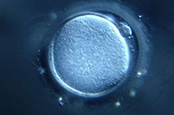Making Human Eggs from Stem Cells
By Kristin Bendikson

Researchers from Massachusetts General Hospital have claimed to generate new eggs cells from human ovarian stem cells. This groundbreaking research team, led by biologist Jonathan Tilly, was published online this past Sunday in the journal Nature Medicine. If validated, this research has the potential to open up a new field of reproductive biology that could have tremendous impacts on the field of infertility.
Women are born with a finite number of eggs in their ovaries. As a woman ages, the number and quality of eggs diminishes. The loss of eggs is a major barrier for fertility physicians as they assist older women conceive.
The researchers have previously worked with mice and have now applied the same methods to human cells. The research initially consisted of marking reproductive cells (eggs) in the ovary. They were then able to retrieve cells from the ovary and sort the cells to separate out the marked cells (eggs). The next step was to then grow the cells in the laboratory to produce immature egg cells. In the previous mice studies, they were able to generate viable egg cells that could be fertilized and produce embryos.
With their new work on human cells, they were able to retrieve reproductive cells from ovaries donated by women at the Saitama Medical Center in Japan who were undergoing sex reassignment because of gender identity disorder. They again were able to retrieve and isolate the reproductive cells and produce immature eggs cells in the laboratory. They then injected the eggs cells into mice, generated follicles (the ovarian structure that contains the egg), as well as mature eggs.
Though incredible, the results of the research need to be viewed with caution until further researchers have been able to replicate the work. In addition, more vigorous studies need to be performed to verify that the cells generated from the ovarian reproductive cells are truly egg cells and the structures formed are genuine follicles.
Even if the results of these studies are real, the use of these types of cells to help infertile women conceive is a long way off. Often times, cells grown in the laboratory can develop abnormalities. There is also no guarantee that even if real follicles with eggs have been created that they could lead to a normal fertilized embryo.
Nevertheless, this research may alter our understanding of the uber complex human egg cell and thus may be one of the first steps to potentially alter a women’s lifetime ability to conceive. It may be feasible in the distant future for young women to have a small biopsy of their ovaries performed in order to retrieve cells that could be grown in a lab into millions of eggs that could be stored for future use. Though a long way off, if ever, it would be an incredible change in how we view fertility.
Here is the link to the New York Times article featuring this research
www.nytimes.com/2012/02/27/health/research/scientists-use-stem-cells-to-generate-human-eggs.html
